The China Navigation Company
Please Note: Firefox and some other search engines are not
suitable – Use “Internet Explorer” for this page to load perfectly!
Click the logo above to reach
the ssMaritime FrontPage for News Updates & “Ship of the Month”
Maritime Historian, Cruise‘n’Ship
Reviewer, Author & Maritime Lecturer
Please Note: All
ssMaritime and other related maritime/cruise sites are 100% non-commercial and
privately owned. Be assured that I am NOT associated with any shipping or
cruise companies or any travel/cruise agencies or any other organisations!
Although the author has been in the passenger shipping industry since 1960,
although is now retired but having completed around
680 Classic Liners and Cargo-Passengers Ships features I trust these will
continue to provide classic ship enthusiasts the information the are
seeking, but above all a great deal of pleasure!

Please Note: Photographs on this page are
from the author’s private collection and from Stan Evans, unless stated
otherwise.
The China Navigation Company’s history in short!
The China Navigation Company’s (CNCo)
and they have their origins in
Within a decade, CNCo had expanded its
operations up and down the
The 1960s and 70s also saw China Navigation
diversifying its scope of activities in two other very different directions.
The first was cruise operations, based in
Introduction:
MS Kuala Lumpur departed Southampton for her
delivery voyage to Hong Kong on October 7, 1960, and upon arrival there she
entered the Taikoo Shipyards where she received a refit making her ready as a
Cruise and a seasonal Muslim Pilgrim ship from
For cruise duties she would accommodate 198 First Class passengers and only her spacious First Class section, but all deck space would be operational. Whilst during her Pilgrim voyages she would accommodate 242 in First Class as well as 1,669 in Third Class or what was originally the more basic troop and educational style accommodations. Whilst previously the air-conditioning had only been in her First Class cabins and public rooms, air-Conditioning was now extended throughout the ship.
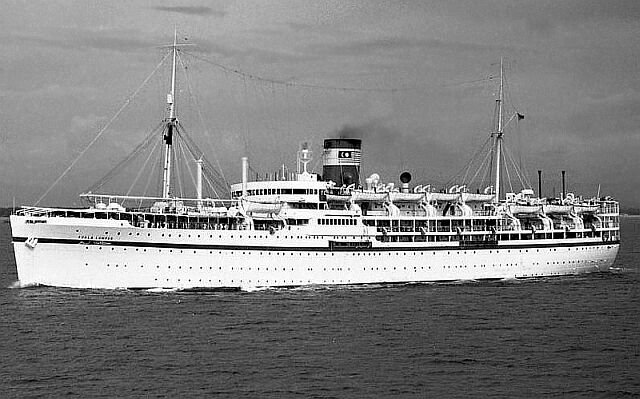
MS
Kuala Lumpur seen as the traditional Pilgrim liner
MS Kuala Lumpur the Pilgrim Liner:
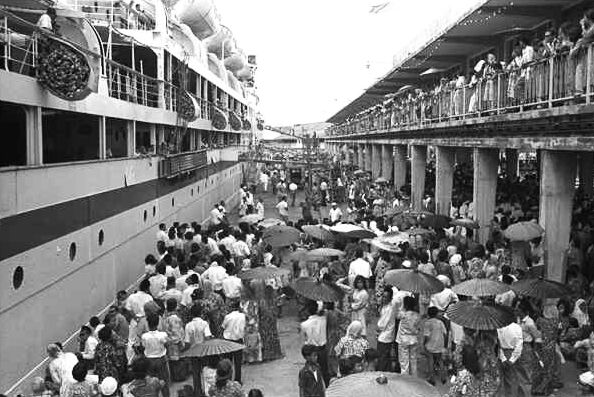
Above and Below: MS
Kuala Lumpur is seen with Malaysian Pilgrims
Photographs provided
by Stan Evans –
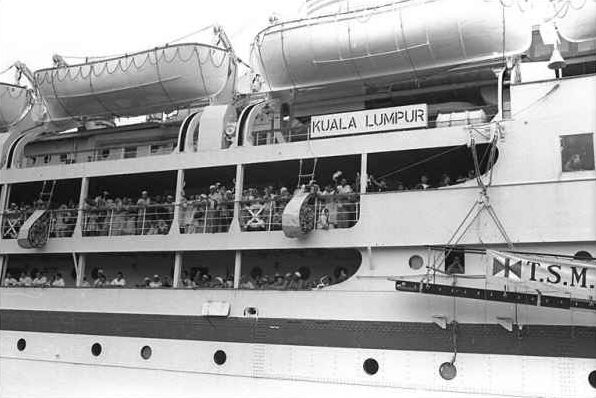
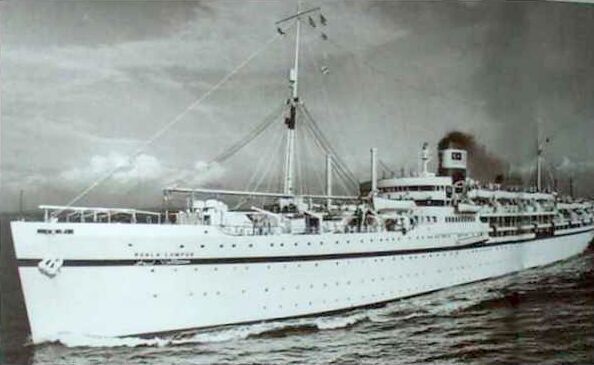
Photo provided by
Stan Evans –
MS Kuala Lumpur the Cruise Ship:
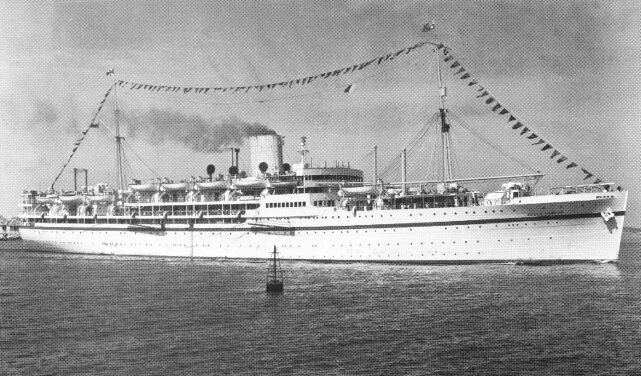
MS
Kuala Lumpur is seen here departing Fremantle for her maiden cruise in
September 1961
Photograph by a great
friend, the late Richard McKenna
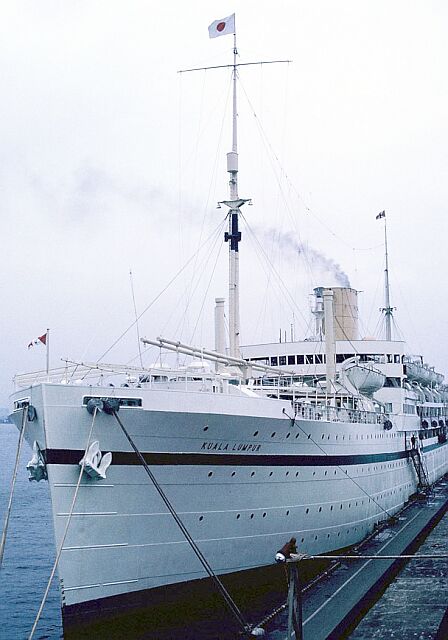
The
MS Kuala Lumpur
Photo by Stan Evans
–
However, China Navigation decided that it was
time for the
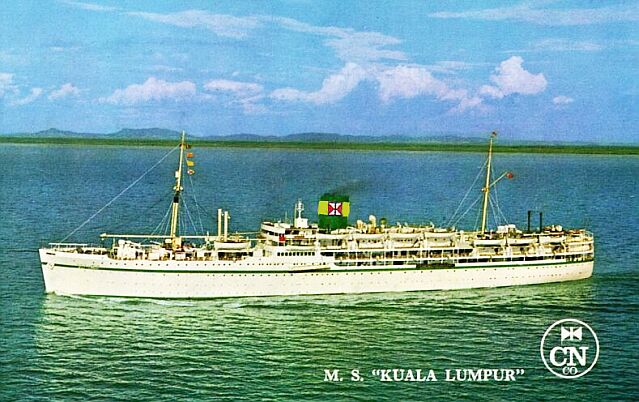
A
postcard featuring the
The following are some of her ports of call during one of her grand circle voyages: Melbourne, Sydney, Rabaul, Yokohama, Kobe, Manila, Port Moresby, Sydney, Melbourne, Auckland, Suva, Apia, Nuku’alofa, Auckland, Melbourne, Sydney and then commence the Asian sector again.
This would create the following cruise sectors
and even further opportunities: 1. An Asian grand circle Voyage from Melbourne
or Sydney. 2. Single Trans Tasman sailings from Melbourne or Sydney. 3. Round
cruises
Kuala Lumpur
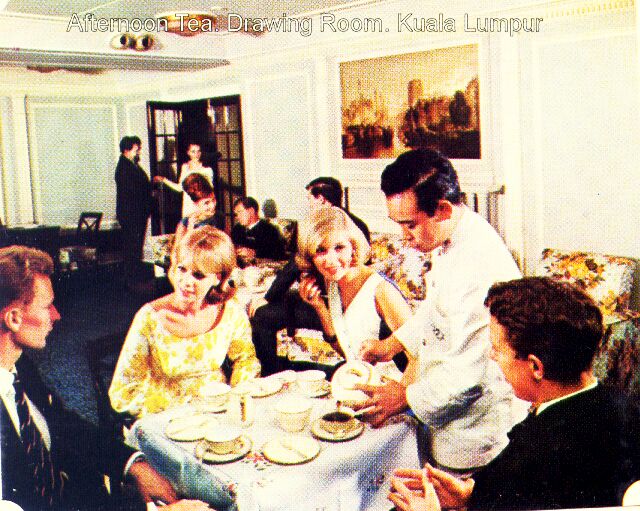
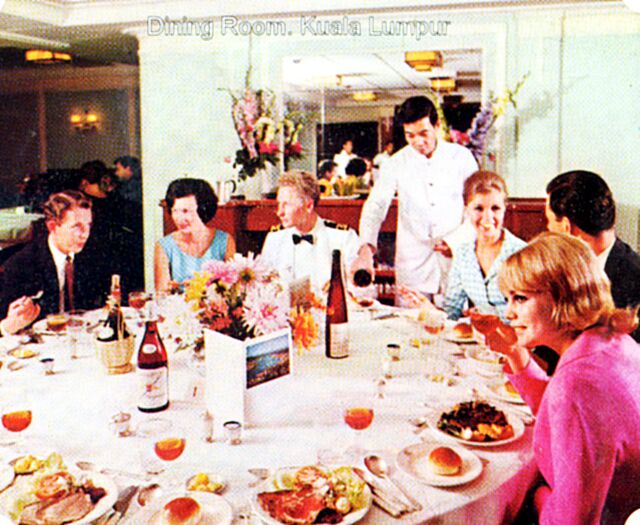
A good friend and long time supporter of mine
and ssMaritime, Mr. Stan Evans, sailed on the MS Kuala Lumpur in July 1962,
being a 12-day cruise from
*****************************
Stan Evans’ Cruise of
the Whitsundays
With Images provided by Stan Evans
–
“In 1968 a friend of mine, Lindsay
Harwood, and I were fortunate enough to have time off at the same time for
holidays from the hospital where we worked, thus we got together and decided to
go on a cruise. Both of us had been on cruises but never together. Thus we
booked on the lovely MS Kuala Lumpur for a twelve-day cruise sailing from
Our cruise cost the princely sum of $364, which to today standards seems to be extraordinary good value for money. I suggested that my recently widowed mother, Mrs. Zeta Evans, join us on the cruise and she travelled as a single passenger in a two-berth cabin that was adjacent to our cabin. We were allocated a twin bedded, inside cabin with private facilities (cabin 441) adjacent to the lobby and close to the main public rooms. Interestingly none of the cabins on board had a loc on the door, thus there was no way of security at all. However, whenever anyone approached their cabin, be it by day or at any time during the night, in port or at sea, a head would emerge from the stewards serving room and “check one out.” They must have had some sort of system, which indicated that someone had opened the door of one of their allocated cabins.”
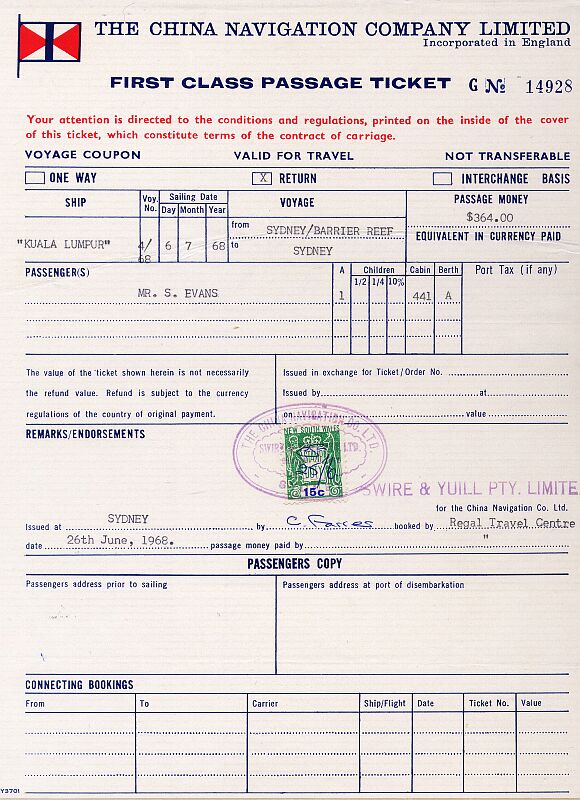
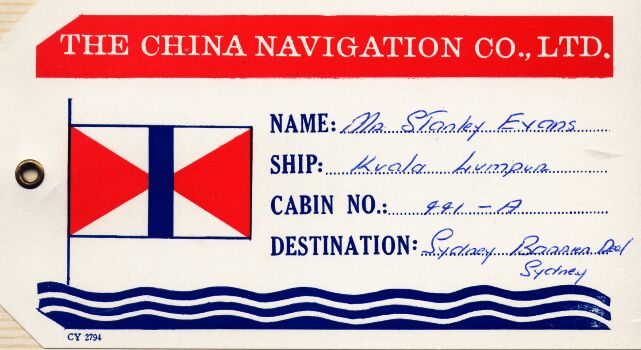
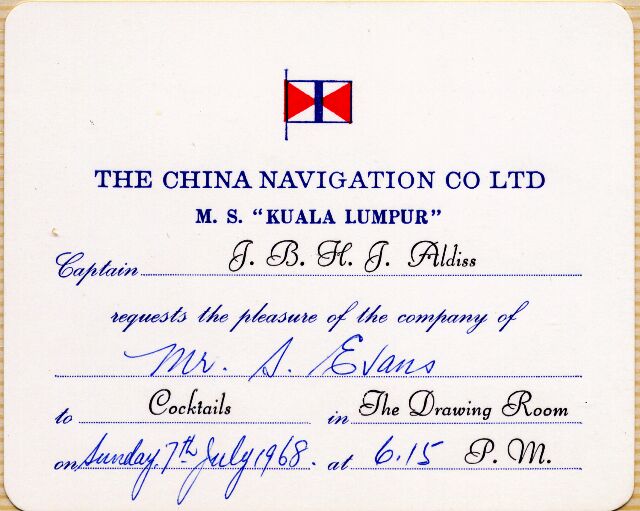
This
was a special party for just ten passengers with the ships senior company
“I well remember my first sighting of
the delightfully spotless motor ship
As we toured the ship together we were struck
by the pristine condition of her decks and all her fittings and the utter
cleanliness of every area, both inside and on deck. I do wish some of the newer
passenger ships were as attentive to cleanliness and presentation as the
But all too soon during the exploration of our
ship we heard the all too familiar gong and the announcement “All
visitors ashore” (two things [a gong] no longer heard these days). This
was always an exciting time as it heralded that departure time was
immanent. We assembled out on deck with the usual streamers linking
passengers and their friends ashore, and then there is that magic moment when
one is aware that the distance between the hull plating and the wharf is
widening and one realises that the adventure has begun. To be honest for
me personally, the most magic moment of any cruise is always that moment
when one crosses the gangplank from the shore to the ship and every experience
is a new one to be relished. MS Kuala Lumpur sailed at 4.30pm and backed out of
the Quay and then picked up speed, past
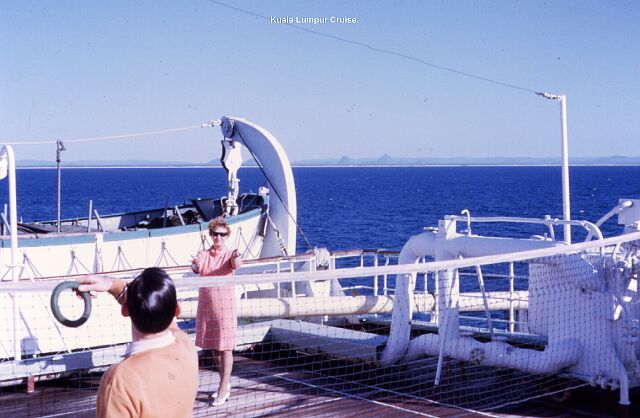
Stan’s
Mother, Mrs. Zeta Evans and cruise mate Lindsay Harwood playing a game of deck
tennis off the
The ship:
“The cabins, which were the first class
section of the ship, and was used as the senior officer’s accommodations
in her previous life as a troop ship, were quite spacious and well fitted
out. The private bathroom was tiled and spotless. All cabins were on two
decks: The upper deck cabins were the original first class cabins and the ones
on the deck directly below contained the original second-class
cabins. However, these cabins were identical, although these had to share
toilet and bathing facilities. The passageways to the cabins were clad in
gently patterned dark green Formica, which was quite reflective, and the
flooring was clad in rubberised non-slip type flooring.
All deck areas were available to passengers and
these included two wonderfully covered and open promenades as well as the
spacious sports decks on several levels, as well as the forecastle deck, well
ahead of the bridge and around the foremast. This area was very popular
with passengers, especially upon arrival and departing a port. There was a
moderately sized swimming pool up on sports deck, but as the cruise was in the
Australian Winter (July), this was not used a great deal, except for a few, and
sunbathing around it as well as out on deck.
As the ship was also used as a pilgrim liner
for part of the year, she also had huge dormitories available for this class of
passenger. These areas were always open to the cruising passengers, and
they were quite light and airy. Exploring them was an interesting pastime. They
were equipped with two and some three level bunks, and also bench-type tables
for meals. During our cruise, one of the dormitories became the haunt of a
group of bridge players who only seemed to emerge from their seclusion for
meals, even when in port. Although they were accommodated in the general cabins
with the rest of the passengers, they were relocated to the dormitory as their
bridge playing would have totally monopolised space in the Drawing Room. Such
was their devotion, or should I say their obsession, that we rarely saw them.
The two main public rooms which I remember
best are the Drawing Room, which was in reality the Main Lounge, and the Dining
Room. These were two most attractive and comfortable rooms. They were
painted in pale green with white trimmings and had such wonderful English
traditional country-home style furniture. There were other public areas as
well but they are lost to my memory in the mists of time.
The Cruise:
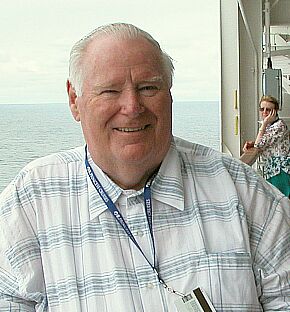 The first three days of our cruise we experienced superb balmy
sea-days and enjoyed the gentle rolling of the ship, as well as the warmth of
both the sun and our fellow passengers as we talked and played on the sports
deck. This was punctuated only by calls to the dining room for yet more of the
bountiful wonderful food that was on offer. Afternoon tea was served in the
Drawing Room and that was one of the most wonderful affairs and all I can say,
it was “ever so British.” A selection of teas was offered,
accompanied by the usual dainty cucumber sandwiches and a selection of
wonderful little cakes served by the ships immaculate staff. To me, these
wonderful sea-days are the stuff of dreams. In the afternoon of the second
day we made an unscheduled stop at the mouth of the
The first three days of our cruise we experienced superb balmy
sea-days and enjoyed the gentle rolling of the ship, as well as the warmth of
both the sun and our fellow passengers as we talked and played on the sports
deck. This was punctuated only by calls to the dining room for yet more of the
bountiful wonderful food that was on offer. Afternoon tea was served in the
Drawing Room and that was one of the most wonderful affairs and all I can say,
it was “ever so British.” A selection of teas was offered,
accompanied by the usual dainty cucumber sandwiches and a selection of
wonderful little cakes served by the ships immaculate staff. To me, these
wonderful sea-days are the stuff of dreams. In the afternoon of the second
day we made an unscheduled stop at the mouth of the
Stan Evans - seen on board MV Dawn Princess October 2009
The Engine Room:
During this run from
Ports of Call:
“Our first port of call was
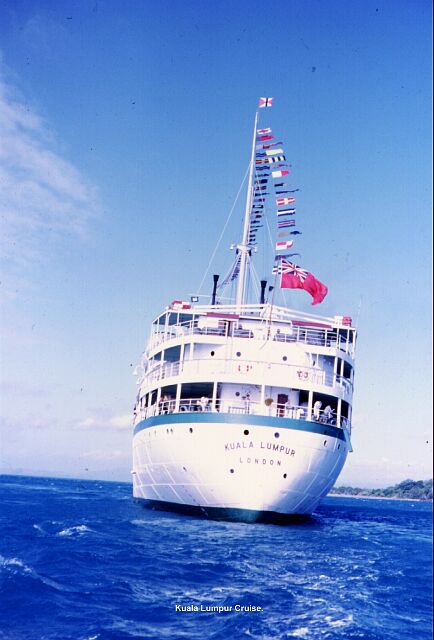
A
fine stern view of the
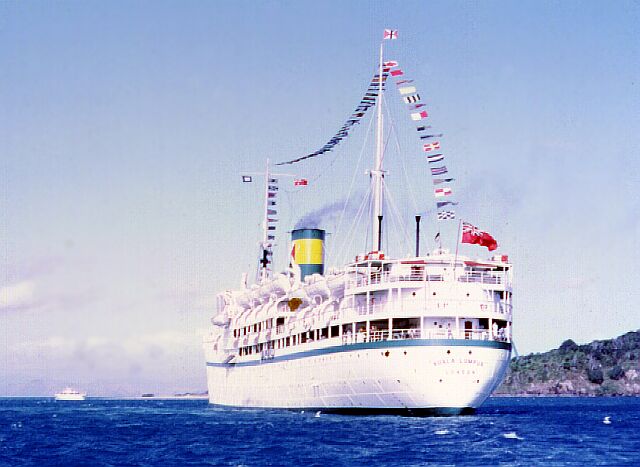
The
pristine
In
the distance, just to port (left) you can see the Sitmar liner, MS Fairsea
Having had a wonderful time in
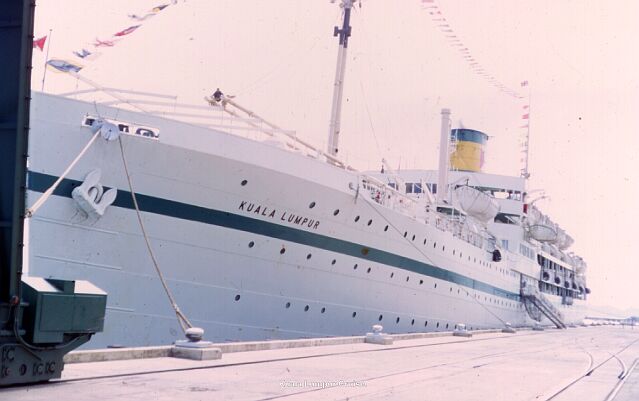
Above and below: MS
Kuala Lumpur is seen berthed in Townsville
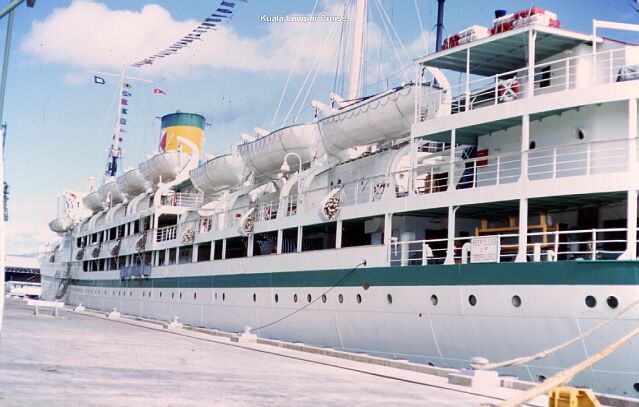
“Entertainment on board in those days
did not include all the huge theatre shows and casinos etc., like we have on
today's cruise ships. But, I remember a wonderful dance exhibition put on
by the ships Pilipino crewmembers and even included the famous “clicking bamboo
poles dance.” Many passengers tried this but ended up with rather bruised
and sore ankles. There was also a wonderful Pilipino band on board and they
would perform at various concerts and at night there would be the ever popular
dancing. They mostly performed in a delightful venue that used to be the
“Verandah Cafe,” but it had now been converted as a general
entertainment and dance venue. In addition there was a wonderful crew
concert, and another that was put on by the passengers themselves, a sort of
“Amateur Hour.” One passenger was a classical pianist and this
person gave a wonderful classical concert one afternoon in the Drawing
Room. In addition movies were shown in the Drawing Room on a number of
occasions during the voyage. We played cards every now and then, and of
course, many, many hours of deck sports, as well as the ever-popular indoor
game of “Horse Races. In some events we competed with either the officers
or the general staff. But the most wonderful parts of the whole trip were
the interactions with fellow passengers and the officers and crew and just the
ship itself as she conveyed her happy and carefree complement of passengers
onward on their journey. The
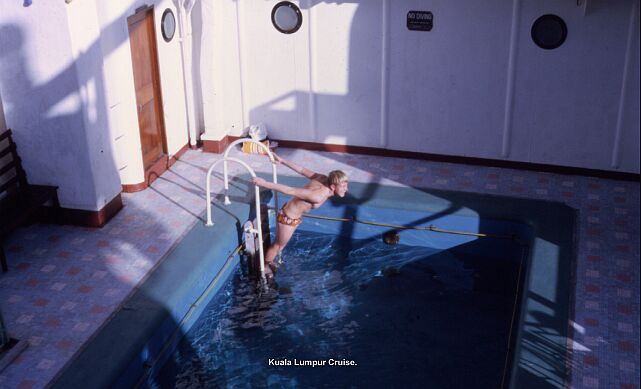
A
fellow cruiser, Michael Grigor going in for a swim
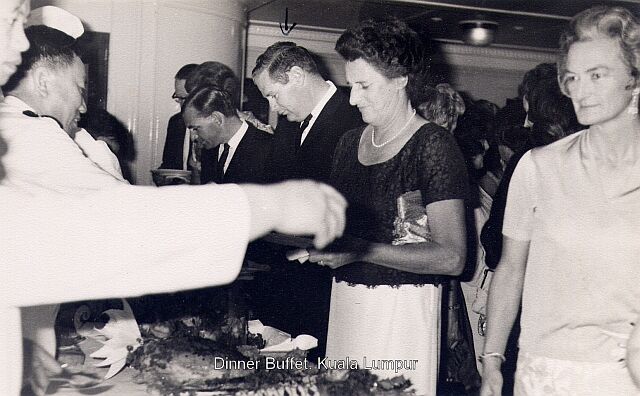
Please Note: All Images in this
story are © Stan Evans!
“I am so happy that I was privileged enough to have known this wonderful ship and her incredible crew, for sailing on her was one of the high points of my cruising events, and I will remember her all my remaining days. It is for this reason that I have asked my friend Reuben to include her history on his wonderful website so that she will have immortality. Little ships like the Kuala Lumpur as well as the China Navigation Companies MS Taiyuan and MS Changsha are all too easily forgotten in these days of so much haste, but to sail on them was to experience the sea and your fellow passengers in a relationship that is simply not seen on today's cruise ships. Life on these fine smaller ships was gentle, dignified, human in scale, and the closeness of the sea in all its moods was more apparent than on today's ships. To tell you the truth, although, like Reuben, I am a frequent cruiser, I really long for the days of yesterday's cruising experience. Cruising on these little ships was to experience nature and the human experience at its most intense level and one returned home refreshed and renewed in both body and soul. These little ships conveyed one to far destinations with a gentle roll and at a pace more at one with inner contentment, self-discovery and general reflection. Life was simple, meaningful and predictable and interactions with fellow passengers, officers and crew were genuine, open and honest.
Thank you Reuben for allowing me to record my recollections regarding my cruise on MS Kuala Lumpur and remembering her has given me great joy and happiness.”
Stan Evans –

*****************************
Obviously Stan Evans had a superb time on this
superb British built ship. But what was so noticeable was the excellent
maintenance on board, for there was not a scrap of rust to be found anywhere
and she was simply spotless and as Stan stated and it is so true, modern cruise
ships sadly are not as well looked after as they used to be! The
Kuala Lumpur
In Conclusion:
What wonderful memories many of us have!
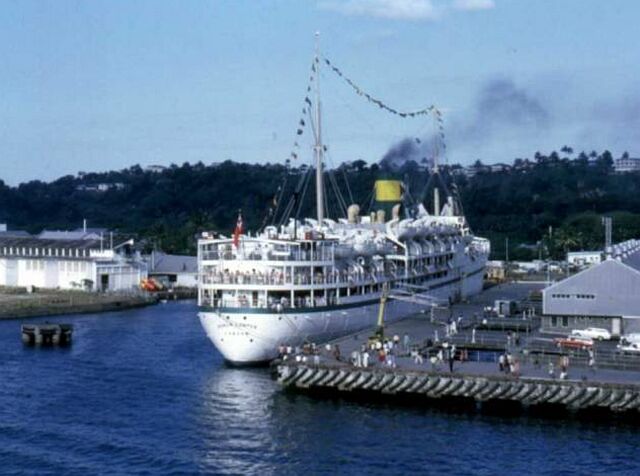
Memories -
MS Kuala Lumpur seen during her final days cruising
*Photographer unknown
– sent in by a supporter. Please see photo notes at bottom of page
As I have already made abundantly clear the MS
Kuala Lumpur was indeed a special ship, and the author has one great
disappointment, for I never sailed on her, but I did visit her on two occasions.
Both times was in Auckland New
Please
Note: I hereby wish to thank my dear friend Stan Evans for his cooperation and providing his cruise review and excellent
photographs and items of memorabilia for this feature for a ship we both
greatly love and admire! Stan has kindly assisted me with other projects and as
you will discover from other pages, he has a great love of classic liners, be
they great liners, or those that are little known. However, these little known
ships are still important as they have touched countless lives! Thank you Stan!
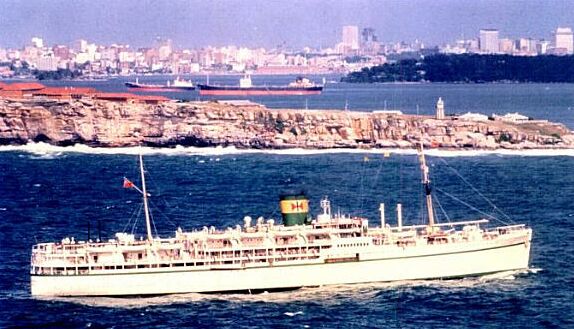
Memories – A great
sight, the
Photograph by Stephen Berry
I trust you have enjoyed reading this page
about this much loved passenger ship, and if you have sailed on her, then I
would like to hear from you! Should you have a story about your voyage or a few
photographs, I would greatly appreciate some, especially those of the interiors
and out on deck. Please email me!
Return to
… Part One …
For other China Navigation Company’s Ships, Read the
following:
MS Changsha
& Taiyuan - MS Anking
& Anshun
“Blue Water Liners sailing to the
distant shores.
I watched them come, I watched them go and I watched them die.”
Where you
will discover around 680 Classic Passenger & Passenger-Cargo Liners!
ssMaritime.com & ssMaritime.net
Where the
ships of the past make history & the 1914
built MV Doulos Story
Please Note: ssmaritime and
associated sites are 100% non-commercial and the author does not seek funding
or favours and never have and never will.
Photographs
on ssmaritime and associate pages are either by the author or from the
author’s private collection. In addition there are some images and
photographs that have been provided by Shipping Companies or private
photographers or collectors. Credit is given to all contributors, however,
there are some photographs provided to me without details regarding the
photographer or owner concerned. Therefore, I hereby invite if owners of these
images would be so kind to make them-selves known to me (my email address can
be found at the bottom of the page on www.ssmaritime.com), in order that due credit may be given.
ssMaritime is owned & © Copyright by Reuben Goossens - All Rights Reserved
